Monday, January 30, 2012
Statement of the Staff Regent on the 10-day Service Recognition Pay for Staff and REPS
Thursday, September 29, 2011
KALATAS NG UP KILOS NA SA PAGHIRANG NG TATLONG BAGONG CHANCELLOR NG ADMINISTRASYONG PASCUAL
Kaninang umaga, Setyembre 29, 2011, hinirang ng UP Board of Regents ang mga chancellor ng UP Los Banos, UP Manila at UP Visayas.
Bagong Chancellor ng UP Los Banos –Dr. Rex Victor Cruz, kasalukuyang Dekano ng College of Forestry and Natural Resources UP Los Banos (http://up.edu.ph/pdf/UPLB%20vision%20papers/RexCruz_Plans_Vision-FINAL%20version.pdf)
Bagong Chancellor ng UP Manila-- Dr. Manuel Agulto, ophthalmologist at director ng Institute of Ophthalmology (http://upm.edu.ph/upmsite/news/news_agulto.html)
Bagong Chancellor ng UP Visayas---Dr. Rommel Espinosa, kasalukuyang Dekano ng College of Arts and Sciences, UPV Iloilo-Miag-ao. (http://www.upv.edu.ph/files/re_vision.pdf, http://www.upv.edu.ph/files/re_cv.pdf)
Ang mga ito, na siya ring inendorso ni Pangulong Pascual, ang magiging kabalikat ng kanyang administrasyon sa pagpapatupad ng kanyang programa sa nalalabing limang taon at limang buwan ng panunungkulan.
Sa tatlong ito, ang napiling Chancellor ng UP Visayas lamang ang may malawak na suporta ng mga estudyante, kawani, REPS at faculty dahil siya ay nagtataguyod ng demokratikong pamamahala sa UP at nagtitiyak na ang galing at dangal ng UP ay iaalay sa sambayanan. Masaya ang mga kasama sa UP Visayas!
Pinaghalong tuwa at lungkot naman ang namamayani sa mga estudyante ng UPLB na pumunta sa Quezon Hall para manawagan ng isang pro-people, pro-student Chancellor. Tuwa, dahil hindi ang kasalukuyang OSA Director, na isa sa mga nominado, ang napili. Lungkot, dahil si Cruz ay bahagi ng administrasyon ni UPLB Chancellor Velasco. Maraming isyu hinggil sa demokratikong pamamahala ang hindi tinugunan, kabilang na ang paliwanag sa gastusin kaugnay ng mga maraming banga na naglilipana sa LB, ang pamamahagi sa mga dekano ng Mac computers at sa mga Vice-Chancellor ng IPads ngayong magtatapos na ang administrasyong Velasco.
Lungkot din ang naramdaman ng mga kinatawan ng estudyante, faculty, REPS at kawani ng UP Manila sa pagkakahirang kay Agulto na walang malinaw na rekord sa pagtindig sa mga usapin ng demokratikong pamamahala sa unibersidad at sa community health medicine.
Malaki ang hamong hinaharap ng mga organisasyong kabilang sa UP Kilos Na sa LB, Manila at Visayas sa pagkakaroon ng bagong administrasyon sa tatlong CUs.
Ang unang hamon ay ang muling pagpapaalaala sa mga bagong hirang na Chancellor sa kanilang mga pangako sa kanilang vision papers. Ang mga sumusunod ay ilang piling halaw mula sa kanilang vision papers:
Cruz (UP LB)
- Set in place mechanisms for regular meeting with the UPLB Executive and Management Committee (at least monthly) to discuss and identify existing as well as emerging problems and provide prompt solutions on issues affecting the administration and operation of UPLB.
- Democratize governance by allowing student representation in the UPLB ExeCom and other related committees and conducting regular consultation, dialogues and forum with students
- Promote transparency in university transactions and democratized formulation of university policies affecting university students, administrative staff, REPS and faculty
- Center for caring, competent, and world class health care and social services that serves all sectors of society, but especially the underserved
- Democratic, participative and transparent governance
- Enhance faculty, staff and student welfare: innovative ways of increasing compensation, inservice training/educational benefits, and health insurance and other benefits
- Continue socio-cultural and health services to the underprivileged, while aiming for technological advancement and modernization of infrastructure and services to everybody
- The students through their councils and organizations should make their voices heard in a comprehensive search process for the next director of the Office of Student Affairs. The OSA Director should approachable, accessible to the students and receptive to their many concerns and problems.
- The faculty and staff unions within the university will be recognized as partners in good governance. Feedback from the unions will be actively solicited regarding the selection and evaluation of personnel to head the offices in middle management. The current set-up will be maintained, wherein there is union representation within policy-recommending bodies like the UPV AdPFC, the UPV AcPFC and the college-level AdPC’s. This will ensure transparency in decision-making and an incentive system based on merit.
Ang ikatlong hamon ay ang pagtitiyak ng partisipasyon ng mga kinauukulang sektor sa pamimili ng mga ilalagay sa mga posisyon bilang Vice Chancellors at Directors ng mahahalagang opisina. Nagawa ito sa UP Diliman. Kayang gawin din ito sa iba pang CUs. Sa ngayon pa lamang, may nagpapaabot na ng malaking agam-agam na” it will be business as usual” sa UPLB; na ang mga dating nakapuwesto sa panahon ni Velasco ay iyon pa rin ang mananatili sa administrasyon ni Cruz.
Ang ikaapat na hamon ay ang pagtitiyak ng accountability ni Pangulong Pascual sa magiging takbo at pamamalakad ng mga Chancellor na pangunahin niyang napili para maging katuwang niya sa pagpapatakbo ng unibersidad. Umaasa ang UP Kilos Na na patuloy na tanganan ni Pangulong Pascual ang pangako niyang demokratikong pamamalakad ng UP bilang modelo sa bayan na kanyang pinaglilingkuran:
"A great university is a model for good governance to the country it serves. TheU.P. leadership must observe the principles of democratic governance based on collegiality, representation, transparency, predictability, and accountability. The practice of good governance should be an ongoing commitment. When contemplating significant policy changes which have wide and far-reaching effects, the U.P. leadership should go through a process of consultation to explain proposed changes thoroughly and obtain feedback. This process may stretch out decision making; however, it will likely hasten implementation. In the management of funds and other resources entrusted to the University,responsible stewardship and ethical conduct should additionally characterize good governance." (http://www.up.edu.ph/pdf/nominees/AEPascual_Vision_Paper.pdf)
Sa panig ng UP Kilos Na --- ang malawak na pagkakaisa ng mga estudyante, guro, kawani at REPS ng UP na nanindigan sa isang demokratikong pamantasang naglilingkod sa sambayanan --- muli naming ipinapangako ang patuloy na pagtindig para sa kagalingan at kapakanan ng nakararaming constituents ng UP. Muli naming idinidiin na ang pang-akademikong kagalingan ay hindi hiwalay sa demokratikong pamamahala at paglilingkod sa bayan. Sa huling pagsusuri, nasa militante at determinadong pagkilos at mahigpit na pagkakaisa natin nakasalalay ang hangad nating UP na naglilingkod sa sambayanan!
Tuloy ang laban!
Igiit ang demokratikong pamamahala sa Unibersidad ng Pilipinas!
UP ang galing mo, ialay sa bayan!
Tuesday, August 23, 2011
Laborer’s son opts to stay, work in the Philippines
Philippine Daily Inquirer, August 23, 2011
UP topnotcher wore red underwear
Philippine Daily Inquirer, August 23, 2011
Monday, August 22, 2011
Proposed 2012 National Health Budget: A perpetuation of government’s neglect on people’s health and welfare of health workers
August 20, 2011
Reference:
MR. JOSSEL I. EBESATE. RN
National President, Alliance of Health Workers
Mobile Phone: 09189276381
The 2012 proposed budget for health increased by 31.7% from P32.427B in 2011 to P42.693B. However, this deceptive increase is not intended to improve public health services or make public hospitals relevant and accessible to poor patients.
The purported increase goes only on the P12.028B allocation for Philhealth subsidy to the poorest 5.2 million families (20% of the population) and P3B for national government counterpart for PPP projects to be implemented on government hospitals starting next year. Minus the P3.5B allocated for Philhealth subsidy for this year (2011), the health budget actually went down by 5% or P152M.
The Philhealth subsidy for the lowest 20% of the population negates the fact that 80% of our people relied on public health facilities for their health needs. Thus, leaving the next 60% of our people vulnerable to the increased health services that will result in the privatization of health services brought about by the PPP projects in public hospitals. The supposed “zero balance billing” for the 22 most common ailments that will be started this September, covers only the poorest 20% of our people, leaving even those in the formal labor sector (and supposedly covered by Philhealth) to absorb the increased hospitalization cost, in excess of the Philhealth capitation. Furthermore, it is a fact that Philhealth capitation covers only about 30% of the total health care costs.
It also failed to provide additional plantilla positions for public health care facilities in spite of admission from the DOH Secretary himself that public hospitals are understaffed by 300% for nurses alone (1:30 nurse-patient ratio in stead of the ideal 1:10 ratio). The 12,000 nurses for 2012 under the RN HEALS program is only an annual (sic - temporary/contractual) employment opportunity, and a " drop in the bucket" compared to the more than 300,000 unemployed or mis-employed registered nurses. The RN HEALS program is also a form of exploitation of our health professionals, comparable to the "volunteer with fees" in hospitals, because nurses under the said program only received P8,000.00 as monthly renumeration, compared to P17,099.00 starting monthly salary for regular government nurses.
The proposed 2012 national budget further decreased by P3M, the allocation for Magna Carta benefits for public health workers from P714M to P711M; instead of increasing it by P1.5B - to include all public health workers at the DedEd, hospitals under the DOH, and other agencies such as PGH and UP Manila (with P250M shortfall). Ever since the enactment of the law (RA 7305) in 1992, the national government failed to allocate funds for these benefits; thus, hospitals under the DOH have been sourcing their Magna Carta benefits from savings and internally generated funds.
Finally, by centralizing the capital outlay of public hospitals under the DOH (through the Facilities Enhancement Program) (P5.078B) at the DOH Central Office; and all unfilled positions in the government (P23.427B) at the DBM, the Pnoy government only perpetuated the lump-sum appropriations practiced by the previous administration, which have been proven to be the source of large scale corruption.#
Tuesday, July 26, 2011
166 Contractual Workers Summarily Dismissed by DOH Seek “Justice”
Sunday, July 24, 2011
PPPs in health threaten to make health care costlier – health workers - Bulatlat
“You go to a public hospital emergency room to have your wound cleaned, you have to first buy some cotton, wound antiseptic, and dressings, before you can be treated,” said Joel Bitanga, 40, an X-ray technician in San Lazaro Hospital.
By MARYA SALAMAT
Bulatlat.com
Sidebar: Health workers blame Aquino’s PPPs for further crippling the Philippine Orthopedic Center
MANILA – After one year, healthcare in the country has gone from bad to worse — this is the assessment of the Alliance of Health Workers (AHW) on the Aquino government’s impact on health. In a series of protests held by its member unions in different public hospitals in Metro Manila, the group aired the various shocks of Aquino’s touted PPPs (public-private partnerships) on the services of public hospitals and the working condition of health workers and professionals in the country. The group challenged Aquino to stop the privatization “in any form” of public hospitals and to bail out public health by infusing it with a P90-billion ($2.09 billion) budget at least.
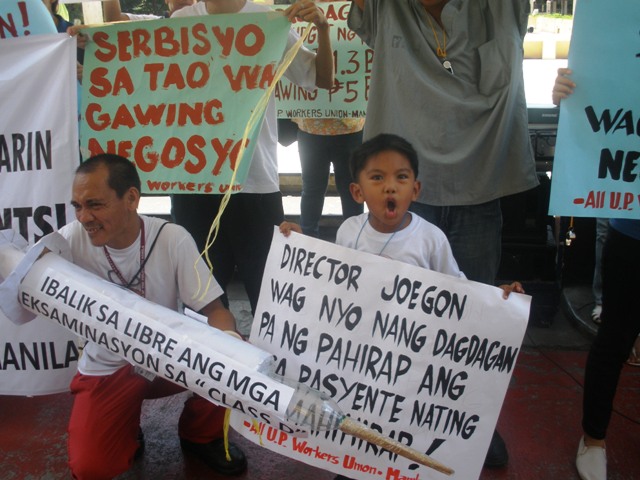
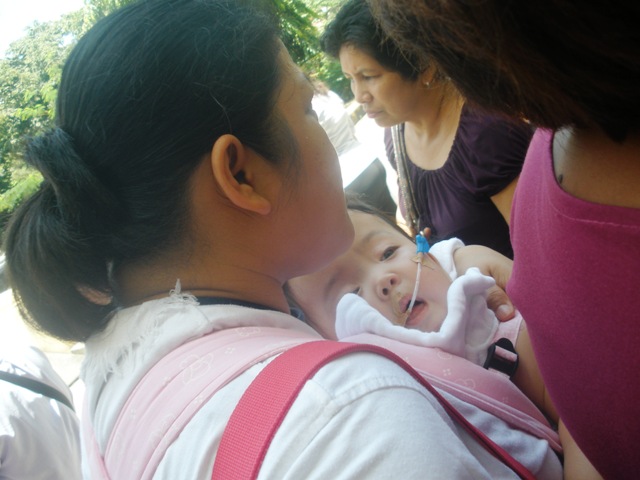
UP-PGH health workers urge their hospital management to revert to giving poorest charity patients free treatment. A mother brought out a child patient. (Photos by Marya Salamat / bulatlat.com)
During Aquino’s first year, the country’s main public hospital, the Philippine General Hospital (PGH), for example, has, for the first time in its history, resorted to charging fees even from its lowest ranked charity or indigent patients. In a memo issued last month, the PGH administration reportedly directed its hospital staff to charge the previously free diagnostic and laboratory examinations of “class D” patients. These are the patients who, according to the hospital social workers, belong to the lowest earners or the poorest of the poor among the four groups who qualify for “social service.” Class D used to receive full support (or full charity), while the other classes under social service get discounts, much like the socialized tuition fees being implemented in the University of the Philippines, explained Jossel Ebesate, AHW national president.
In the Philippine Orthopedic Center, fees have been drastically increased early this year, with some increasing more than twice its old amount.
Because of the budget cutbacks implemented by the Aquino administration in the budget for maintenance and other operating expenses of public hospitals, the previous shortages in medicines, supplies and other equipment have become worse, reported the AHW. The exacerbated shortage in turn prompted the administrations of public hospitals to increase fees and to charge fees on previously free items in the hospital menu of services.
“You go to a public hospital emergency room to have your wound cleaned, you have to first buy some cotton, wound antiseptic, and dressings, before you can be treated,” said Joel Bitanga, 40, an X-ray technician in San Lazaro Hospital. He added that if you were brought to their hospital and you can’t breathe, you have to buy the hose and other paraphernalia for your oxygen.

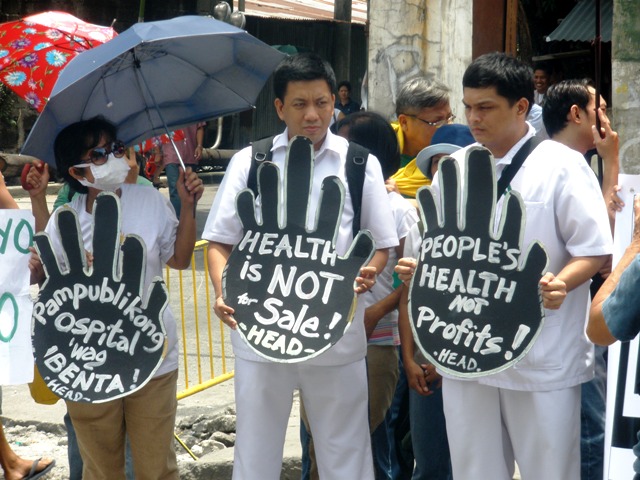
Health workers and a child urge the Aquino government to treat healthcare not as source of profit but as public service.(Photos by Marya Salamat / bulatlat.com)
Picketing in front of San Lazaro Hospital, then at Jose Reyes Memorial Medical Center and in front of the Department of Health, the health workers decried last Monday the increased fees also prevalent in the Philippine Heart Center, the Lung Center of the Philippines, the National Kidney and Transplant Institute (NKTI), the Philippine Children’s Medical Center (PCMC) and the East Avenue Center (EAMC). These are some of the hospitals retained by the national government after it implemented a devolution of health services in 1992.
The practice of charging and increasing fees which the majority of low-income Filipinos are already finding as tough, would likely worsen if the Aquino government pushes through with its planned PPPs targeting even government hospitals, the AHW warned.
Already, the health group noted that some private companies that were able to get concessions in public hospitals have been profiting from this public-private partnership. They cited as example Himex, which provides the radiology “services” of Jose Reyes Memorial Medical Center; the Carte-blance in Lung Center which profits from its dietary services; and Fabricare for Lung Center’s laundry. In PGH, the privately-operated Faculty Medical Arts Building has begun operations this year.
In public hospitals being operated by local government units, a measure of success is the increase in hospital income, which could be
had by adding “private” or “pay wards” and other services that charge fees. The biggest example, for having been the first to be declared as a corporatized hospital is the La Union Medical Center. Provincial hospitals are now trying to follow its example, after its local governments have sent their public hospitals’ directors and staff to “Lakbay Aral” (Study Travel) to learn from “successful” provincial public hospitals.
Up for starting new PPPs soon are the Philippine Orthopedic Center (POC), the San Lazaro Hospital and the Research Institute for Tropical Medicine (RITM). While the moves are seeking to improve and upgrade the said hospitals – something which the health workers’ union said they also wish to happen – they are decrying the fact that these have to be planned under a PPP setup. They urged the government instead to fund the needed development, rather than enter into partnerships with the private sector whose motives for entering health services are mainly for profit.
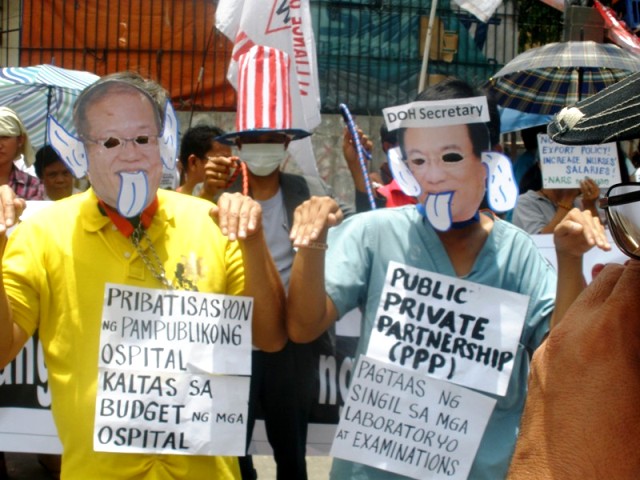
Health groups blame US imperialist dictates for Aquino’s drive to privatize and commercialize healthcare.(Photo by Marya Salamat / bulatlat.com)
“What will happen to our mentally ill patients? Will they be abandoned on the streets?” asked Arman Palaganas, vice-president of the health workers’ union in National Center for Mental Health. This mental hospital and the Philippine Heart Center are up for bidding in a public auction set to be held under the Aquino administration, the AHW reported.
When all these upcoming PPPs happen, the AHW warned, health care will become even less accessible to ordinary Filipinos.
Killing you softly
Given the frequently slashed budgets, health workers’ wages and benefits have also taken a beating. In fact, the Department of Budget and Management itself has told public hospital administrators and even local government units that benefits being given to health workers are contingent on the hospital’s savings or on the availability of funds. The result, according to AHW, is either lacking or almost nil benefits especially for health workers under the local government units.
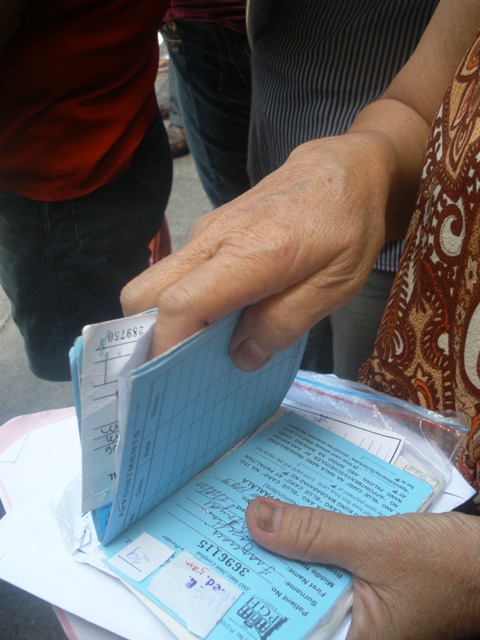
A PGH patient’s charity cards and papers attesting to her indigency could mean little now in terms of free or affordable treatment. (Photo by Marya Salamat / bulatlat.com)
For twenty years now, the country’s plantilla position for health workers and professionals have barely increased, despite the continued pressure of population increases. Worse, while the plantilla positions are being controlled, the AHW noted that the ranks of the country’s health workers are under attack and being reduced by bouts of retrenchment or streamlining through transfer, attrition and early retirement.
Instead of replacing the lost regular health workers, AHW noted that the government itself has been increasingly implementing “flexible labor arrangements,” a favorite under profit-oriented corporations. In the health sector, these arrangements range from contractualization, job-order employment (similar to project-based hiring), and the notorious “volunteerism” where the hospitals not only do not pay the health professionals who serve them but even make them pay for the “training” and “experience.”
As if to gag the health workers’ groups who have been criticizing and providing proofs of the government’s abandonment of its responsibility top ensure the people’s health, there are alleged moves from public hospital managements to bust the health workers’ unions, or else “deceive, divide and crush” the progressive unions under the Alliance of Health Workers. The AHW complained that the management of some public hospitals, such as the National Center for Mental Health, Jose Reyes Memorial Medical Center, Philippine Orthopedic Center and Philippine Children’s Medical Center, “do not recognize and even try to coerce the accredited sole bargaining unit.”
As such, judging from the way the government has been treating Filipinos as patients and as health workers, the health group charged that “the people has never been Aquino’s real ‘boss,’ as he had boasted, but the politicians, the local big landlords and the big local and foreign investors.”
The poor cannot survive under the Aquino government’s health agenda of privatization, the Health Alliance for Democracy said in a statement. The poor will get sicker and die sooner if the rate increases continued, said PGH nursing attendant Ellen Jamison in a picket protest in front of the PGH this week.
The health groups encourage health workers and the families of patients in public hospitals to join in protesting privatization and pushing for health as a human right. ![]()



